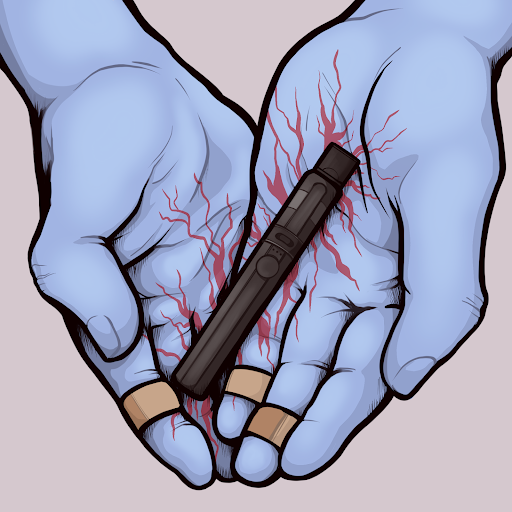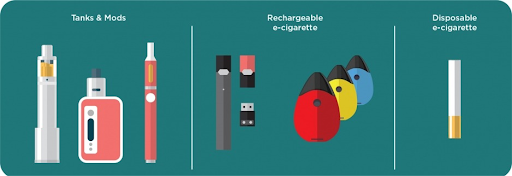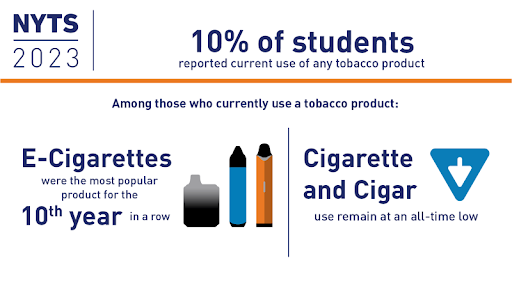
There were smoking sections in airports and restaurants. People would take smoke breaks during work or stay out late with a box of cigarettes. In movies, people were shown smoking pipes with a glass of whisky and cool kids were portrayed skipping class to smoke cigarettes with friends.
Nowadays, smoking has been painted in a more critical light. A little hobby once seen as a way to relax is now proven to cause life-threatening health effects.
Many people still smoke but most have completely switched their view on cigarettes.
However, with each apparent step toward health, there seems to always be something standing in the way.
In smoking’s case, it is vaping.
Instead of smoke breaks, it’s vape breaks.
TikTok spreads videos of people performing tricks with vapor from e-cigarettes.
Students conceal vape pens as USB drives. It is normal to walk into a school bathroom and be hit with the sweet, artificial smells of a recent vape circle.
Like cigarettes or other smoking tools, vapes are used to inhale a set amount of airborne stimulant drug- usually nicotine.
However, these little devices are much more complicated than their cigarette counterparts.
According to the National Institute of Drug Abuse, “vaping devices are battery-operated devices that people use to inhale an aerosol, which typically contains nicotine (though not always), flavorings, and other chemicals.”
Packed with an internal heating system and a liquid solution, vapes can be found in all shapes and sizes; Around “460 different e-cigarette brands are currently on the market.”

Instead of the smoky taste of a cigarette, vapes come in many different sweet and addicting flavors. A hit can taste like blue raspberry or strawberries and make a user’s room smell like a candy store. This attribute makes e-cigarettes more appealing to anyone, especially adolescents.
Vaping has become a much larger problem for today’s youth, even characterized as an epidemic by the CDC.
According to the U.S. Food and Drug Administration, for the tenth year in a row, e-cigarettes have reigned #1 over all tobacco products. Of the total population of tobacco consumers, 10% are students, 12.6% of those students were reported to be high schoolers and 6.6% reported to be in middle school.
Here at Broomfield High School, a survey conducted of 267 students showed that 6.74% of kids admittedly vape, with the highest percentages among 10th and 11th graders.
Like cigarettes, vapes require a user to inhale a puff of airborne substance which is then absorbed into the bloodstream from the lungs.
The nicotine within the liquid “stimulates the adrenal glands to release the hormone epinephrine (adrenaline). Epinephrine stimulates the central nervous system and increases blood pressure, breathing, and heart rate,” according to the National Institute of Drug Abuse.
Along with these side effects, nicotine activates the reward circuits in the brain increasing dopamine levels and reinforcing behaviors with feelings of reward. This is what creates addiction.
For young people whose brains aren’t fully developed, this can lead to “harmful consequences for parts of the brain that control attention, learning, mood, and impulse control,” according to an article from the CDC. Nicotine also interrupts a brain process called synapses (which helps make strong brain connections through memory) and can lead to a young person becoming more susceptible to addiction.
Furthermore, many studies have shown that vaping is heavily associated with creating or heightening serious mental health issues such as anxiety, depression, and even suicidal ideation among teens throughout the US.

Vapes, although less physically dangerous than smoking, are still highly addictive and expose the lungs to harmful chemicals found in the vapor. Chemicals such as nickel, chromium, and cadmium have been discovered and can lead to lung diseases and breathing problems in the future.
Smoking is known to be detrimental for a person’s health and vaping, (contrary to how they are marketed positively in the media) is no better.
Many kids already know how harmful it could be for them.
“I knew I had a nicotine addiction. I knew it was addictive and could cause serious damage to the brain. Vaping made it hard to breathe, remember important details, and heighten my anxiety till I took a hit,” said an anonymous BHS student, “but it was too hard to stop.”
So why do kids choose to start and continue to keep their habits?
According to a National Library of Medicine study that collected data from 4,066 students of varying ages claimed, “common reasons for vaporizer use reported by respondents who had ever used a vaporizer were, experimentation (53.0%), taste (37.2%), boredom (23.5%), having a good time (22.4%), and relaxation (21.6%).”
Some start because everyone else around them is trying it. Some start because they are curious. Others start because they desperately need relaxation or a coping method for depression, anxiety, or other mental health crises. However, no matter the reason for starting, vaping has been shown to create a long-lasting addiction.
Many young people find the vast amounts of flavors to be appealing. With more than 7,700 different flavors to choose from, it is easy to get hooked due to the thrill or the taste and stay hooked because of the nicotine.
“Vaping is much nicer than cigarettes,” said a BHS student, “but with vaping it’s very easy to get lost because of flavors and new variations.”
Here in Colorado and many states, there are recent legal actions that prohibit teens under 21 from purchasing their own tobacco devices, including e-cigarettes.
Sections 1 through 8 of the Colorado Act HB20-1001, commonly known as “Nicotine Product Regulation,” make the minimum age to purchase any sort of cigarettes, tobacco products, and nicotine products 21 years of age.
Along with this, it requires the product retailer to “card anyone seeking to purchase products who appears to be under 50 years of age at the time of purchase.”
Making underage purchases of nicotine products illegal will create an environment that makes underage nicotine use harder to achieve but it is not a one-all-be-all solution. It is still incredibly easy to purchase vapes from friends, family, or co-workers, and vaping in schools is still easy to find.
These little devices serve many different purposes. Some of these can be good in the right contexts such as helping long-time smokers quit or reduce cigarette use, but in many cases, vaping consequences outweigh the small minority of benefits they give. Especially with the youth.
If anyone vapes and wishes to quit, find more resources through the Tobacco Education Resource Library and reach out for help.















